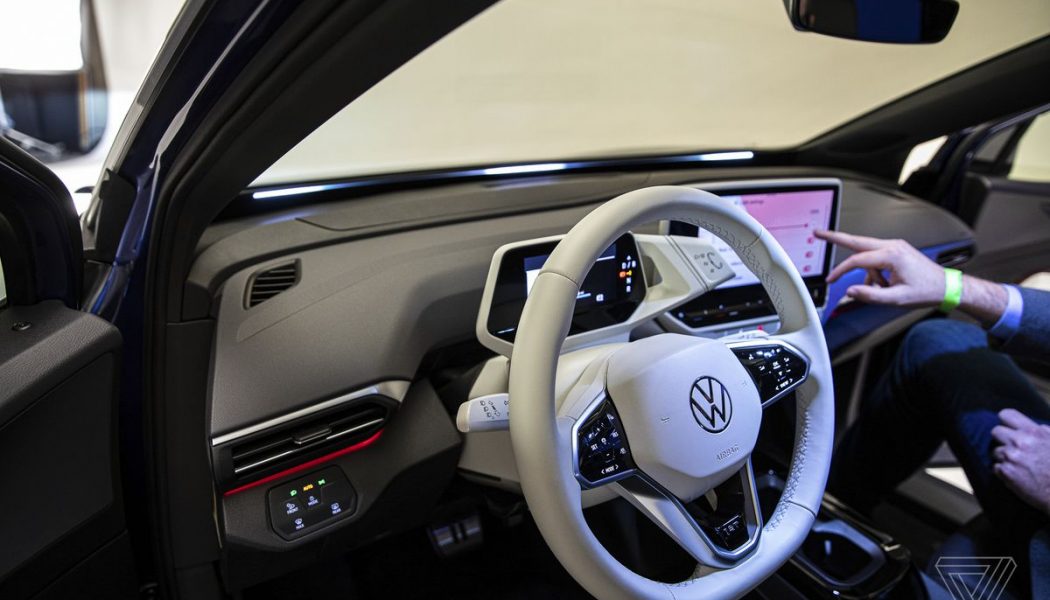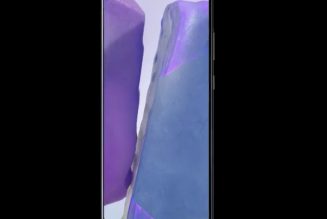When I first got to see Volkswagen’s new ID 4 electric SUV at an eerily empty launch event in Brooklyn last month, the company’s executives warned me not to make the obvious comparisons to other electric vehicles, namely Tesla. That was because Volkswagen’s real targets are popular gas-powered compact SUVs, like the Ford Escape, Honda CR-V, and Toyota RAV4. VW has its eyes on a higher prize.
A couple weeks later, as I climbed into the front seat of the ID 4 for a brief test drive across Manhattan, my main objective was to see how this car stacked up against those other popular players. Compact SUVs are one of the most popular segments in the American car market, and as a compact SUV owner myself (2010 Subaru Outback, what what?), I felt uniquely qualified to tease out the ID 4’s quirks.
I only had about 45 minutes with the car, but I was able to drive through a number of different traffic conditions, from bumper-to-bumper traffic in upper Manhattan, to bumper-to-bumper traffic in midtown, to bumper-to-bumper traffic on the West Side Highway. We also skittered across a variety of potholes, sinkholes, and other pockmarks that are the hallmark of NYC’s streets.
Which is to say I wasn’t cannonballing down a misty mountain road or through some perfectly empty cityscape like in a car commercial. This was real city driving, crawling through crowded corridors, squeezing through narrow gaps between trucks and city buses, cheek by jowl with other drivers. The kind of conditions that show you what a car is made of.
In that respect, the ID 4 held its own. The steering was responsive, the shocks mostly soaked up all the bumps in the road, and the acceleration was pleasantly torque-y like you would expect from a rear-wheel-drive electric motor. But the ID 4 wasn’t showy or demanding about any of it. The good thing about this car is that it’s nondescript but not boring. It looks like a typical VW with a few futuristic flourishes. I received no second glances from passersby and was able to blend into my environment, which typically isn’t the case with a new EV. (I’m looking at you, Polestar 2.)
:no_upscale()/cdn.vox-cdn.com/uploads/chorus_asset/file/21903684/akrales_200915_4161_0336.0.jpg)
Still, there are a lot of impressive design touches that make the ID 4 stand out from the rest. The LED headlights flow backward, giving the impression of forward motion. The illuminated VW logo sits in the middle of the grille-less front end. And the ID 4’s shape moves through the air crisply, with VW citing a drag coefficient of 0.28.
While driving, you would expect a low-grade motor whir common with EVs, and you’d be right. After all, there was no noisy combustion under the hood to radiate throughout the vehicle’s interior. As you accelerate, the motor definitely emits a higher-pitch sound, but not distractingly so. I can’t speak to what the car sounds like from the outside, but EV makers are adding fake noises in order to comply with new pedestrian safety regulations. VW hasn’t revealed what the ID 4’s exterior sound will be yet, but Porsche, a VW subsidiary, offers an interior $500 “Electric Sport Sound” in the configurator for its electric Taycan sports car.
Thanks to a narrow A-pillar and a stubby front end, I felt like I could see everything I was supposed to from the driver’s seat. So many SUVs on the market today have gargantuan front-ends, creating dangerous front blind spots for drivers that could be fatal, especially for children. Compact SUVs don’t typically have this problem, but it felt like VW made the necessary design choices to ensure maximum visibility.
Inside, the ID 4 was roomy and bright. VW’s branded lighting system, ID Light, gave off a festive vibe, like I was rolling in my own personal dance club on wheels. Blue light emanated from below the windshield, beneath the center console, and from behind the controls on the doors. I wish I had more time to play around with the color settings, but I was able to change the background on the 10-inch infotainment screen from orange, to green, to yellow and blue. It was a welcome splash of color for a car interior.
What else about the screen? It was angled slightly toward the driver, so it felt accessible without being distracting. The interface was pleasant and easy to navigate. And the placement of the home button on the left-hand side of the screen felt intuitive and easy to access.
:no_upscale()/cdn.vox-cdn.com/uploads/chorus_asset/file/21903697/akrales_200915_4161_0056.0.jpg)
The voice assistant, which is activated by saying “Hello, ID,” left a lot to be desired. In its press materials, VW claims that the ID 4’s functionality is “almost completely controlled by touch or voice control.” But I found myself having to repeat myself a lot, and I was constantly getting tripped up by the long lag time between the wake words and actually saying what you want the assistant to do. VW says the voice assistant is still in beta and will be much improved when the ID 4 starts shipping to customers in early 2021.
Again, it was only a brief test, but the ID 4’s advanced driver assist system appeared to be highly capable, with adaptive cruise control, lane-keep assistance, blind spot detection, and all the bells and whistles typically found in most new cars.
I can’t speak to the car’s range or charging time, as I didn’t have it long enough to make determinations about either. VW says the ID 4 has an EPA-estimated range of 250 miles, which should be perfectly adequate for city or suburban driving. The automaker also thinks that’s a conservative estimate, meaning it could end up being closer to 300 miles after the government has had a chance to test it. Stay tuned for that.
One of the big selling points for the ID 4 is three years of free charging with VW’s Electrify America charging network. Like Tesla, VW has skin in the game when it comes to EV charging infrastructure, which will go a long way in luring shoppers away from the warm embrace of combustion engine familiarity. Electrify America has approximately 470 charging stations in the US, with over 2,000 DC fast chargers — though the company expects to install or have under development approximately 800 stations with about 3,500 DC fast chargers by December 2021.
A fast, reliable network of charging stations will go a long way in selling the ID 4 to customers. The $40,000 price tag (before the federal government’s $7,500 EV tax credit) will help, too. But it’s still going to be tough for VW to siphon buyers away from low-priced alternatives like the Honda CR-V (which starts at $25,150) or Toyota RAV4 ($26,050), especially as the Japanese giants roll out more fuel-conscious, hybrid models of their popular crossovers.
The ID 4 is a strong contender, with its effortless appearance and top-notch specs, but if price is any indicator, it’s going to be an uphill battle for VW’s battery-powered crossover to cross over into the mainstream.









